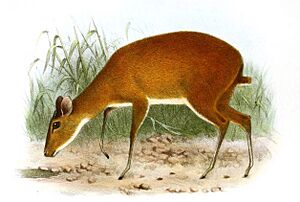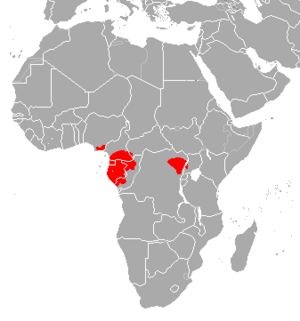Bates's pygmy antelope facts for kids
Quick facts for kids Bates’s pygmy antelope |
|
|---|---|
 |
|
| Conservation status | |
| Scientific classification | |
| Genus: |
Nesotragus
|
| Species: |
batesi
|
 |
|
| range | |
| Synonyms | |
|
|
The Bates's pygmy antelope (Nesotragus batesi) is a super tiny antelope. It's also called the dwarf antelope or pygmy antelope. This little creature lives in the wet forests and bushy areas of Central Africa and West Africa. It's related to another small antelope called the suni.
Contents
Meet the Bates's Pygmy Antelope
This antelope is one of the smallest in the world! Adult Bates's pygmy antelopes weigh about 2 to 3 kilograms (4.4 to 6.6 pounds). That's like a small house cat! They are about 50 to 57 centimeters (20 to 22 inches) long. Their tail is quite short, only about 4.5 to 5.0 centimeters (1.8 to 2.0 inches).
Only the male antelopes have horns. These horns are small, usually about 3.8 to 5.0 centimeters (1.5 to 2.0 inches) long. Their fur is a shiny dark chestnut color on their back. It gets lighter on their sides. Male antelopes are a bit bigger than the females.
Where Do They Live?
Bates's pygmy antelopes are originally from tropical Central Africa. They live in three main areas. One is in southeastern Nigeria. Another is in the lower part of the Congo Basin. The third area is in the northeastern Democratic Republic of Congo, stretching into western Uganda.
They love humid lowland forests. They especially like places with thick plants growing close to the ground. You can also find them in farms, forests that are growing back, and even near human homes. They are quite good at adapting to different places.
What Do They Eat and How Do They Live?
Bates's pygmy antelopes are herbivores. This means they eat plants! Their diet includes leaves, buds, and new shoots. They also munch on fungus, grass, and other herbs. Sometimes, they eat crops from farms. This can make farmers unhappy. They are sometimes caught in traps set near farm fields.
These antelopes usually have a territory of about 2 to 4 hectares (5 to 10 acres). Male antelopes protect their territory. They mark it using a special scent from glands near their eyes. Female antelopes are more friendly with each other. They might even live in small groups. When they get scared and run away, they make a barking sound.
Most pygmy antelopes mate during the late dry season and early wet season. A baby antelope grows inside its mother for about 180 days. That's about six months! Usually, only one baby is born at a time. A newborn fawn weighs between 1.6 and 2.4 kilograms (3.5 and 5.3 pounds).
Are They Safe?
Good news! Bates's pygmy antelopes are not considered endangered right now. However, they are losing some of their natural homes. As more people live in their areas, it can affect their future. But these antelopes are quite good at adjusting. They can live in forests that are regrowing. They can also live near roads and in village gardens.
People do hunt these antelopes for food, but not on a large scale for business.


